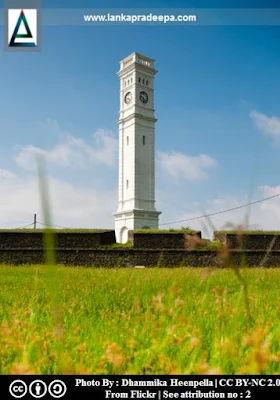
The Matara Fort (Sinhala: මාතර බලකොටුව; Tamil: மாத்தறைக் கோட்டை) is an ancient fort situated in Matara District, Sri Lanka. It has been erected on the land between the sea and the estuary of the Nilwala Ganga River.
.
History
Although the fort at Matara is believed to have been built by the Portuguese during the period of Dharmapala of Kotte (1550-1597 A.D.), the actual fort was built by the Dutch sometime after they took Matara, after the capture of Galle from the Portuguese in 1640 (Abeyawardana, 2004; De Silva, 1988; Mandawala, 2012). The fort was the sole Dutch defence at Matara when a rebellion took place there in 1760 mainly due to the Dutch endeavour to register peasants' holding of lands and either to dispossess or tax them if they couldn't prove title (De Silva, 1988). Sinhalese forces backed by the Kandyan Kingdom captured the Matara Fort in March 1761 and held it for nearly one year (Abeyawardana, 2004; De Silva, 1988; Wikramaratne, 2015). The Dutch retook the fort in February 1762 and decided to erect the Star Fort on the western bank of the Nilwala Ganga River to strengthen their defences (De Silva, 1988; Wikramaratne, 2015).
The date 1789 A.D. is found recorded over the entrance of the fort and that is believed to be the date of a later restoration and strengthening of the fort and not the date it was built (Abeyawardana, 2004). On 24 February 1796, the fort was ceremoniously handed over to the British by the Dutch (Abeyawardana, 2004; Wikramaratne, 2015).
The fort
The fort has been built with coral and stones (Abeyawardana, 2004). The rampart and the entrance of the fort still remain. The rampart is about 240 m long, 13 m thick and 5 m tall with two side lengths of 80 m each (De Silva, 1988). The central projection is 70 m along each side and 70 m from point to base (De Silva, 1988). The gate has been set somewhat south of the centre of the northern section of the rampart (De Silva, 1988). During the Dutch period, the fort is said to have been used as the commanding base for the inland forts at Katuwana, Akuressa and Hakmana. Also, there was an elephant stable at the site where the present District Secretariat building is located (Abeyawardana, 2004).
A few monuments that are dating from the Dutch and British periods are found inside the fort. The Dutch Reformed Church is considered one of the earliest surviving monuments dating from the Dutch period [(1656-1796 A.D.) Abeyawardana, 2004]. The courthouse, the resthouse, the police station, and the clock tower (1883) are a few buildings belonging to the British period [(1796-1948 A.D.) Abeyawardana, 2004; Wikramaratne, 2015].
The rampart and the gate of the fort were restored in 1985-86 by a Dutch firm named Ballast Nedam (De Silva, 1988).
A protected site
The fort rampart (in land plot no. 6 of the Mulika Pimbura no. 12876), in the Divisional Secretary’s Division
of Matara, is an archaeological protected monument, declared by a
government gazette notification published on 18 January 1974. Attribution
References
1) Abeyawardana, H.A.P., 2004. Heritage of Ruhuna: Major natural, cultural and historic sites. Colombo: The Central Bank of Sri Lanka. ISBN:
955-575-073-4. pp.65-67.
2) De Silva, R.R.K., 1988. Illustrations and Views of Dutch Ceylon 1602-1796: A Comprehensive Work of Pictorial Reference with Selected Eye-Witness Accounts. Brill Archive. pp.173-179,180-181.
3) Mandawala, P.B., 2012. Sri Lanka: Defending the military heritage; legal, administrative and financial challenges. Defending the military heritage; legal, financial, and administrative issues. Reports from the Seminar 16 – 17 May, 2011, in Karlskrona, Sweden, organised by ICOMOS International Scientific Committee for Legal, Financial and Administrative Issues (ICLAFI) and the Swedish Fortifications Agency of Sweden. p.101.
4) The Gazette of the Democratic Socialist Republic of Sri Lanka. No: 95. 18 January 1974.
5) Wikramaratne, I., 2015. Pauranika Sthana Saha Smaraka: Matara Distrikkaya (In Sinhala). Department of Archaeology (Sri Lanka). ISBN: 955-9159-54-2. pp.55-57,59-60.
2) De Silva, R.R.K., 1988. Illustrations and Views of Dutch Ceylon 1602-1796: A Comprehensive Work of Pictorial Reference with Selected Eye-Witness Accounts. Brill Archive. pp.173-179,180-181.
3) Mandawala, P.B., 2012. Sri Lanka: Defending the military heritage; legal, administrative and financial challenges. Defending the military heritage; legal, financial, and administrative issues. Reports from the Seminar 16 – 17 May, 2011, in Karlskrona, Sweden, organised by ICOMOS International Scientific Committee for Legal, Financial and Administrative Issues (ICLAFI) and the Swedish Fortifications Agency of Sweden. p.101.
4) The Gazette of the Democratic Socialist Republic of Sri Lanka. No: 95. 18 January 1974.
5) Wikramaratne, I., 2015. Pauranika Sthana Saha Smaraka: Matara Distrikkaya (In Sinhala). Department of Archaeology (Sri Lanka). ISBN: 955-9159-54-2. pp.55-57,59-60.
Location Map
This page was last updated on 14 August 2022


